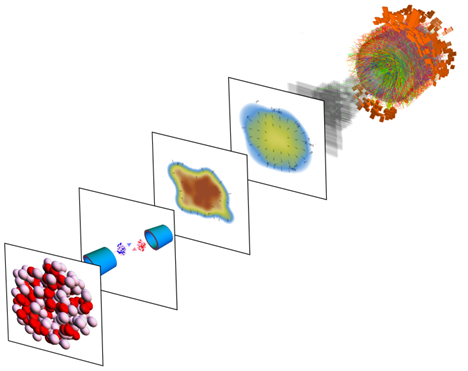The outer layer of heavy nuclei, like lead-208, primarily comprises neutrons and is referred to as the neutron skin. The protons and neutrons' constituent quarks and gluons melt into a state of matter known as the quark-gluon plasma when these nuclei collide at nearly the speed of light.
 At the CERN Large Hadron Collider, lead nuclei (left) are collided to form a quark-gluon plasma (middle), which eventually decays into particles (right). Image Credit: Govert Nijs and CERN
At the CERN Large Hadron Collider, lead nuclei (left) are collided to form a quark-gluon plasma (middle), which eventually decays into particles (right). Image Credit: Govert Nijs and CERN
The thickness of the neutron skin influences the size and shape of the quark-gluon plasma formed by these collisions. This enables the inference of this thickness from experimental observations.
The Impact
The strong interaction between protons and neutrons affects the size of the neutron skin in an atomic nucleus. The behavior of the material that makes up neutron stars is controlled by the same interaction.
With a radius of only roughly 6 miles and a mass roughly one to two times that of the Sun, these are some of the most enigmatic objects seen in the sky. Thus, measurements of Earth's neutron skin allow us to learn more about these extreme celestial objects.
Summary
The quark-gluon plasma formed in high-energy collisions between two nuclei is shaped and sized differently depending on how thick the neutron skin of a heavy nucleus is. Consequently, particle detectors at the Large Hadron Collider measure the distributions of particles released from these collisions.
To explain these collisions, scientists have created complex theoretical models. These models include sophisticated tools that let scientists adjust the model's parameters to explain a wide range of experimental data points.
One of the researchers was funded by the Deutsche Forschungsgemeinschaft (DFG, German Research Foundation) under Germany’s Excellence Strategy (the Heidelberg STRUCTURES Excellence Cluster). Another researcher was funded by the Department of Energy Office of Science, Office of Nuclear Physics.
Journal Reference:
Giacalone, G., et al. (2023) Determination of the Neutron Skin of 208Pb from Ultrarelativistic Nuclear Collisions. Physical Review Letters. doi.org/10.1103/physrevlett.131.202302